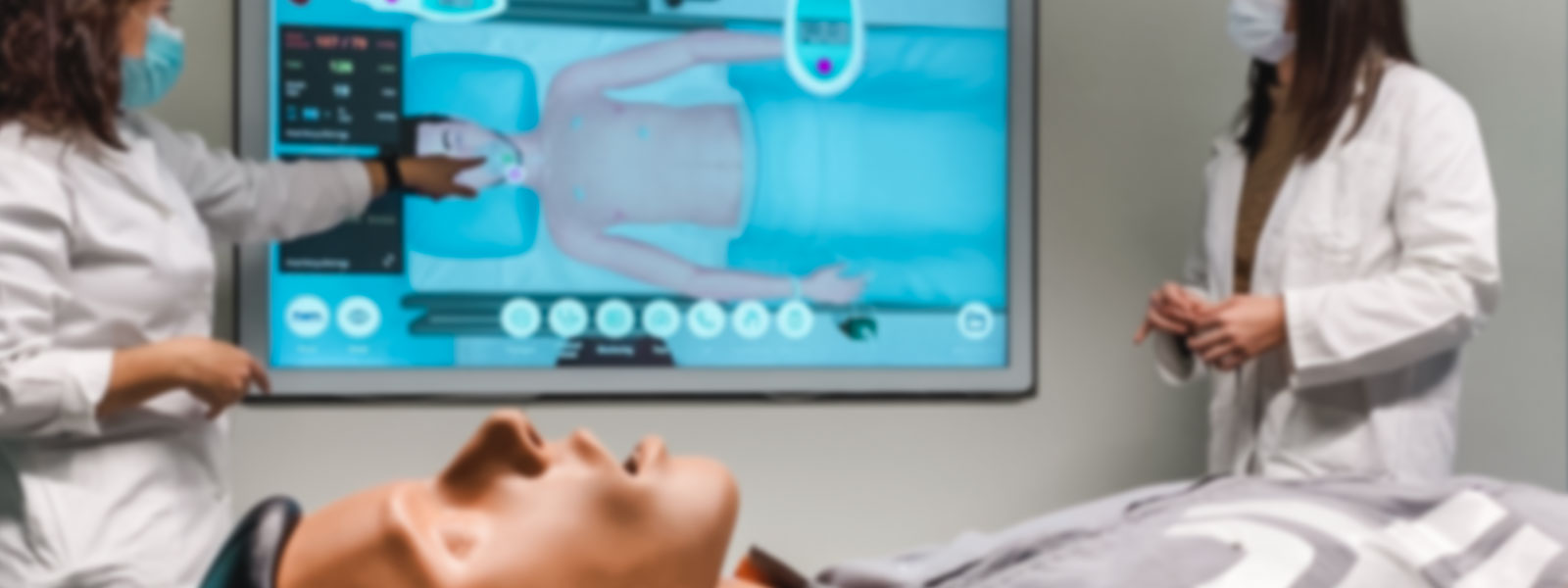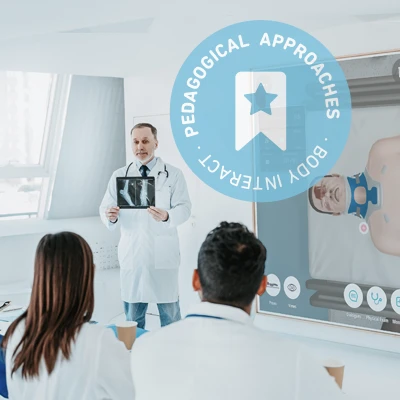Pedagogical Approach with Body Interact | Simtegration
What is Simtegration in Clinical Education?
Simtegration, a concept crafted by the Body Interact Team and successfully implemented by Body Interact clients, can be defined similarly as hybrid simulation or hybrid simulation-based training. [1]
It is an educational strategy that combines two or more simulation modalities – integrating Virtual Patients (VP) with standardized patients, task trainers, manikins, or high-fidelity simulators – to create a more realistic, comprehensive, and immersive learning experience for healthcare learners.
“Hybrid simulation refers to the combination of different simulation modalities, such as a standardized patient paired with a part-task trainer, in order to address both technical and non-technical skills within a single educational encounter.” [2]
Key components of Simtegration
Simtegration, although it is a flexible educational approach, has some components based on the fact that it is a simulation-based approach which should be taken into account:
- Multimodal Simulation: Use of at least two simulation resources (example: VP + manikin or standardized patients or task trainer).
- Scenario Design: Possibility of integrating cognitive, psychomotor, and affective domains in the learning experience.
- Role-play and Realism: A Realistic environment that includes professional roles, documentation, and communication elements.
- Debriefing: Structured reflection immediately after simulation to consolidate learning.

Role of Virtual Patients in Simtegration
VP may be the central figure of this educational approach, as they can:
- Act as the starting point for clinical reasoning before transitioning to hands-on practice.
- Simulate complex decision-making and diagnostics without requiring physical setups.
- Be used before and/or after procedural simulation to assess reasoning, decision-making, critical thinking, triage, or prioritization skills.
What are the benefits of Integrating Body Interact Virtual Patients in Simtegration?
- Enhances both self-efficacy and collective efficacy among medical students, providing evidence that this cost-effective approach can foster critical psychological attributes linked to better team collaboration and clinical performance. [1]
- Enhances clinical reasoning and decision-making under time pressure.
- Provides a scalable, adaptable, and more accessible teaching method for enhancing essential medical competencies. [1]
- Supports both individualized and team-based learning and the development of non-technical skills (such as communication, confidence, and teamwork).
- Facilitates safe error analysis and reflective practice.
- Provides context for procedural skills development and evaluation.
- Foster students’ engagement and attention.
- Creates room for skills integration and a holistic and integrated learning experience.
- Allows for the development of a cost-effective learning experience by making use of existing resources.

Best Practices for Implementing Simtegration with Body Interact
1. Align with learning objectives
Choose simulation resources based on the targeted competencies and the selected scenario of Body Interact.
2. Clearly define all aspects of the Simtegration experience
Learning goals of the activity, level of the audience, Body Interact virtual scenario, key interventions to be taught, trained, or assessed, simulators, and remaining required resources, and instructions for standardizing the activity (both for professors and students).
3. Create checklists
In order to easily double-check and assure that everything needed is prepared and available create checklists.
4. Integrate debriefing
Reflect on performance to reinforce learning.
5. Start with simple scenarios
Scenario selection is a crucial step, start with manageable scenarios and progressively increase complexity.
7. Engage learners
For increased realism and immersion engage participants in role-based interactions.
Explore the video to get an idea how you can implement it
Who is using this educational strategy?
Would you like to explore the vision of some of our clients integrating this approach into their curricula? Go through the posts from St. Luke’s Medical Center College of Medicine and the College of Western Idaho.
Simtegration offers a valuable opportunity to teach, train, and assess students across cognitive, psychomotor, affective, and communication domains—maximizing the use of existing resources within your institution.
Looking to Evolve Your Teaching Methods?
Curious to learn more about this innovative pedagogical approach? Or interested in sharing how you’re using it in your teaching practice? We’d love to hear from you!
References
1. Tam, C. Y. W., Dizon, J. I. W. T., Sin, S. W. C., Tang, G. K. Y., Lai, V. Y. W., Wong, Y. Y., Yeung Ng, P. (2025). Implementation of hybrid simulation training to promote collective and self-efficacy in medical students: a two-pronged approach. Annals of Medicine, 57(1). https://doi.org/10.1080/07853890.2025.2527362
2. Brown, W.J., Tortorella, R.A.W. Hybrid medical simulation – a systematic literature review. Smart Learn. Environ. 7, 16 (2020). https://doi.org/10.1186/s40561-020-00127-6
2. Daly, M., Mulhall, C., O’Neill, J. et al. Effectiveness of hybrid simulation training on medical student performance in whole-task consultation of cardiac patients: The ASSIMILATE EXCELLENCE randomized waitlist-controlled trial. Adv Simul 9, 40 (2024). https://doi.org/10.1186/s41077-024-00314-2









